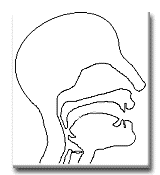 Harmonic singing (or overtone
singing) vs normal singing Harmonic singing (or overtone
singing) vs normal singing
Harmonic singing shares techniques with diphonic singing, overtone singing, xoomi singing, sygyt singing, throat singing, Tuva singing etc.
We explain some of the acoustics of this style of singing in terms
of the measured acoustical response of the vocal tract.
In this technique, the singer emphasises one high harmonic of
the voice to such an extent that it is heard separately from
the low pitched note being sung. Different notes in the harmonic
series may be chosen by changing the frequency of the resonance
in the vocal tract that gives rise to it.
For background information on speech and ordinary singing,
see our Introduction
to the acoustics of the vocal tract. For background about
our research and techniques, see this
link. On this page, we begin by looking at how the vocal
tract behaves for a whisper, where
the resonances of the tract are most clear, then for normal
singing, then for harmonic singing. But first, some sound examples:


In the first, Jer Ming Chen (a postdoctoral researcher in this lab) sings his own tune, called Desert Lullaby. In the second, he sings up a harmonic series, starting at the fourth harmonic. No treatment of the recording. How does he do that? We'll need to start with some background first.
Whisper. In the first figure,
a subject whispers the vowel in 'hoard'. We show the frequency
response of the vocal tract (For an explanation of the measurements,
follow this link.)
The sound of the whisper itself is masked by the injected signal
used to measure the vocal tract resonances. The figure shows
several peaks, indicated by the arrows. At these frequencies,
the sound produced at the vocal folds is most effectively transmitted
as sound produced in the external air. (Technically, these are
peaks in the acoustic
impedance of the vocal tract. At these resonant frequencies,
the tract operates most effectively as an impedance transformer
between the relatively high acoustic impedance of the tract
and the low impedance of the radiation field at the mouth.)
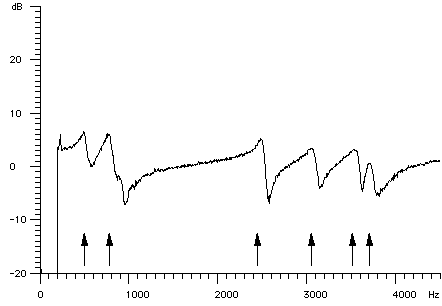
Normal singing. In the figure
below, the subject sings the same vowel at the pitch Bb3 (117
Hz). In this graph, you can see the harmonics of the voice,
and you can see that the fourth and sixth harmonics appear stronger
in the sound spectrum because they are near resonances of the
tract.
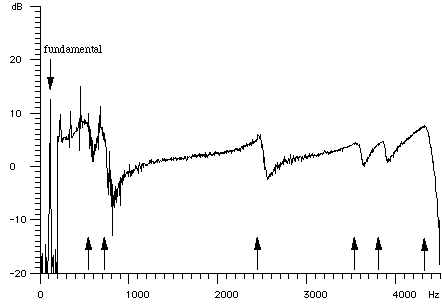
Over the range shown and for this vowel, this subject's
vocal tract has six resonances, which are indicated by the
arrows. Note that the subject changes the first two resonances
a little between whispering and singing. The frequencies of
these two resonances determine the vowel in a particular accent.
It is not unusual for people to have different accents when
whispering, speaking and singing. The higher resonances are
also substantially changed, probably because rather different
vocal mechanisms are used in whispering and singing.
Harmonic singing. The next
graphs show two examples of harmonic singing. In this technique,
one of the vocal tract resonances is made much stronger, while
all the others are weakened. The strong resonance can be made
so strong that it selects one of the harmonics and makes it
so much stronger than its neighbours that we can hear it as
a separate note. Hear it is the eighth harmonic that is amplified.
Although the fundamental is only 8 dB lower than the selected
harmonic, the fundamental lies in a range in which our ears
are much less sensitive, so it sounds much less loud.
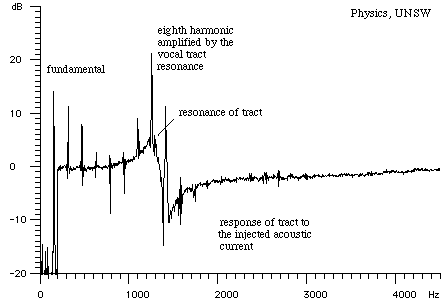
How do you do it? With some difficulty! One way to strengthen
the second resonance, at the expense of the others, is to
make a small mouth opening and also a relatively tight constriction
between the tongue and the roof of the mouth. But mainly it
takes a lot of practice, using feedback. Usually the feedback
comes from finding a reasonably reverberant environment (bathroom,
stairwell) and listening for the individual harmonics. (Another
type of feedback is to use a live display of the spectrum, using your computer's
sound card. Yet another display uses the graphs shown here.)
In traditional practice, some singers hold the sung pitch
(fundamental) constant, and then tune the vocal tract resonances
to choose one or another harmonic. They can therefore play
the 'instrument' using the natural harmonics, just like players
of the natural
trumpet or horn. Skilled practitioners can vary the voice
pitch and the resonant frequency independently. In the next
graph, the fundamental has been lowered and the resonance
has been raised, with the result that it is the twelfth harmonic
that is amplified.
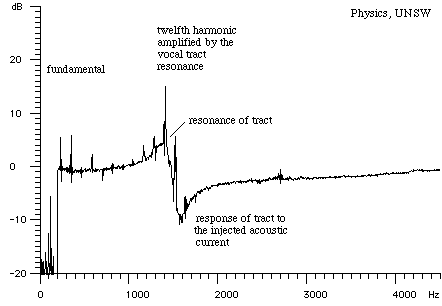
For some harmonic singers, more complicated effects than
those described here may be involved. It has been suggested
that, for some sygyt singers, the strong resonance in the
vocal tract may drive an oscillation in the false vocal folds.
This could produce a stronger signal at the high pitch. Further,
because the false vocal folds would be nonlinear oscillators,
they would produce strong components at integral multiples
of the high pitch frequency, ie at n*fo, 2n*fo, 3n*fo etc.
This research is part of a project investigation the acoustics
of singing in general. It is undertaken by Nathalie
Henrich, John
Smith and Joe
Wolfe.
Some related pages and explanatory notes
Some explanatory notes
|

